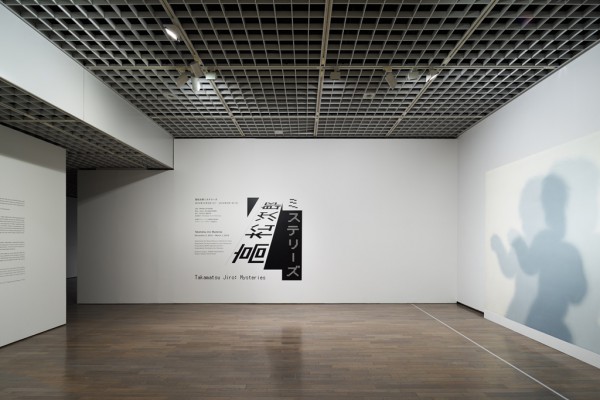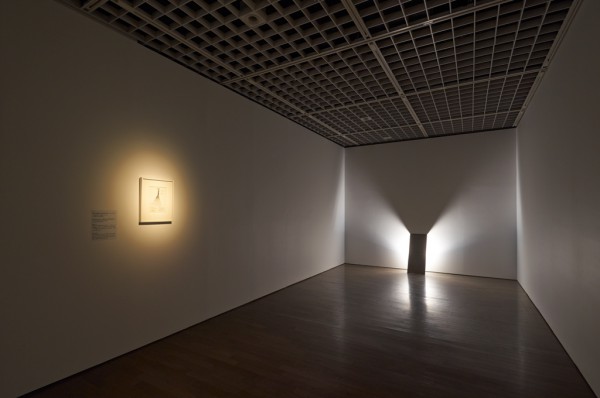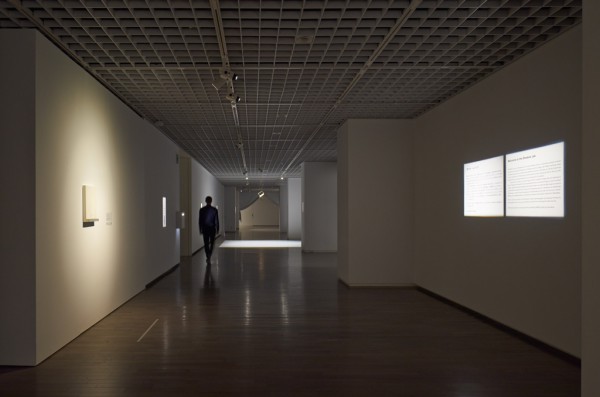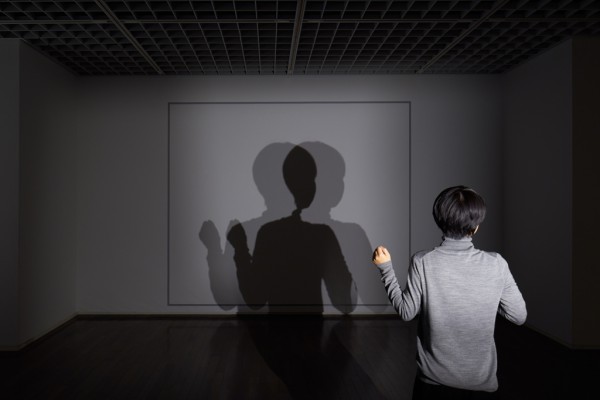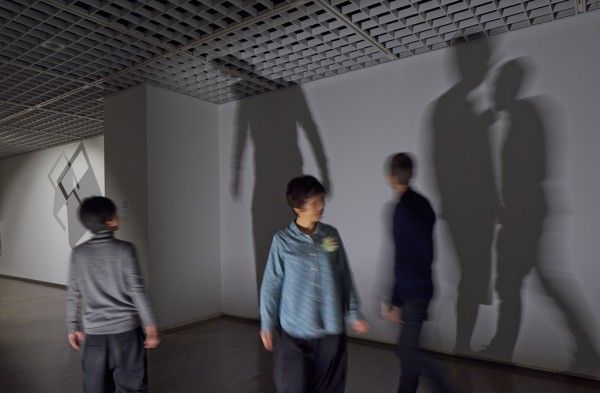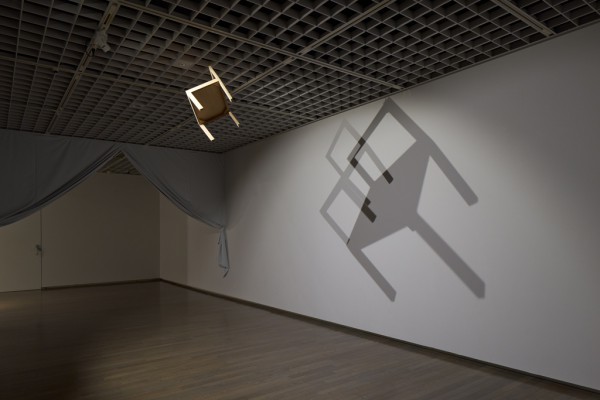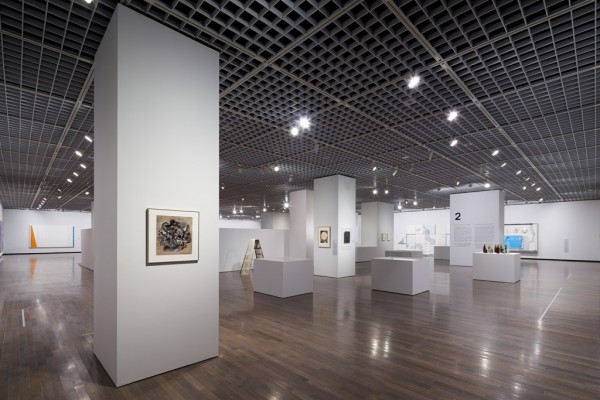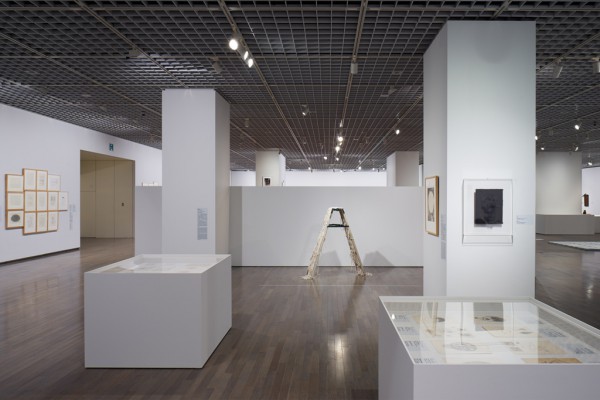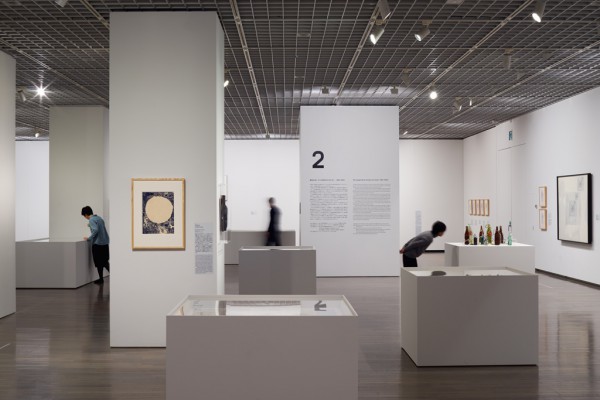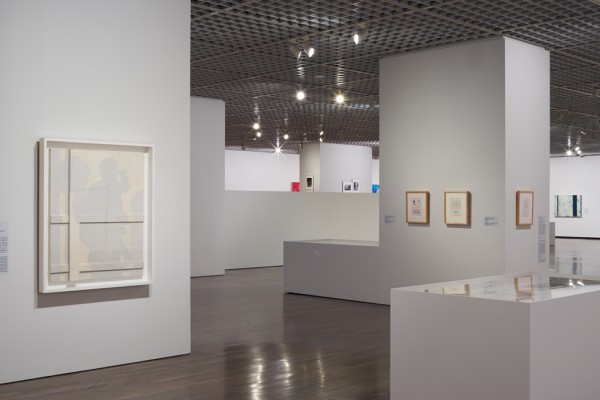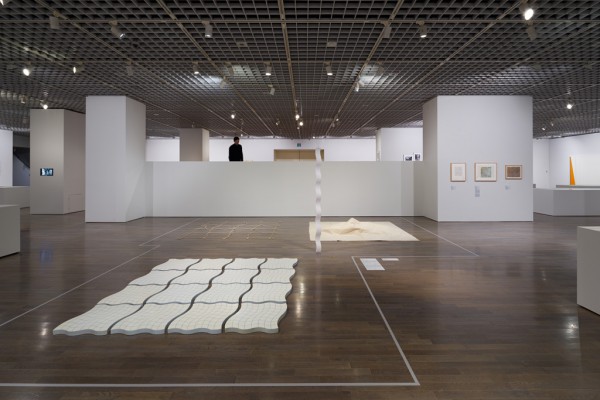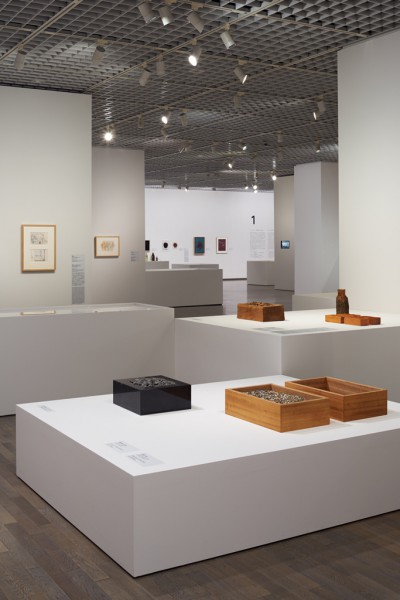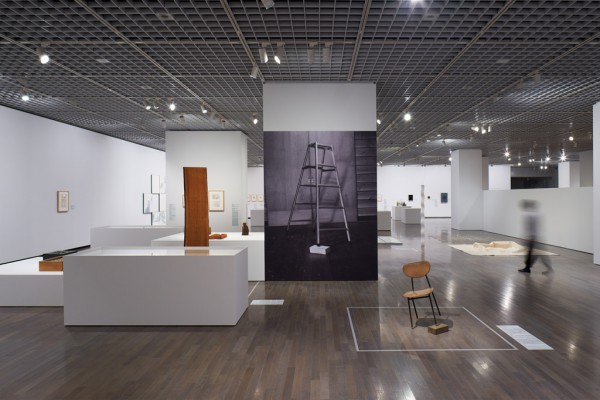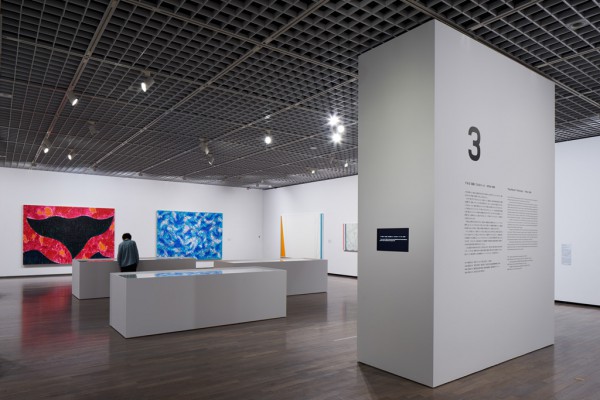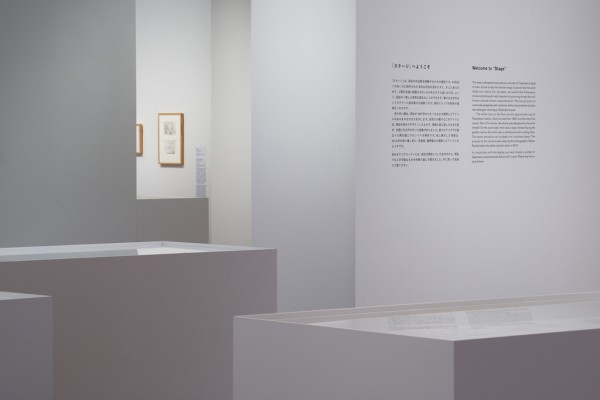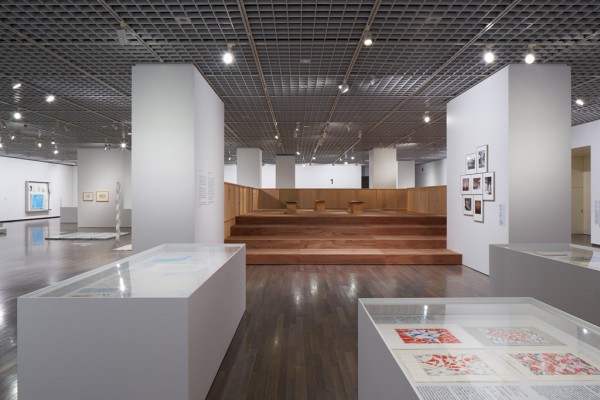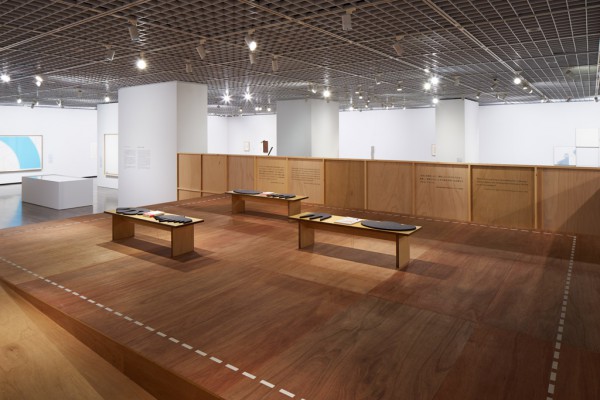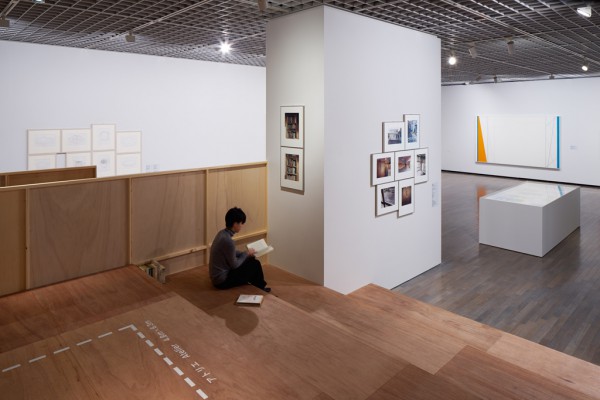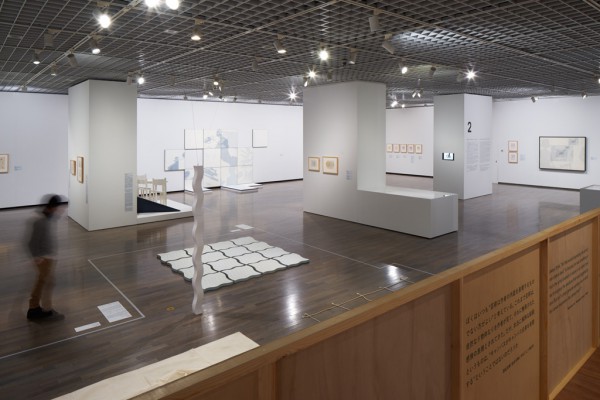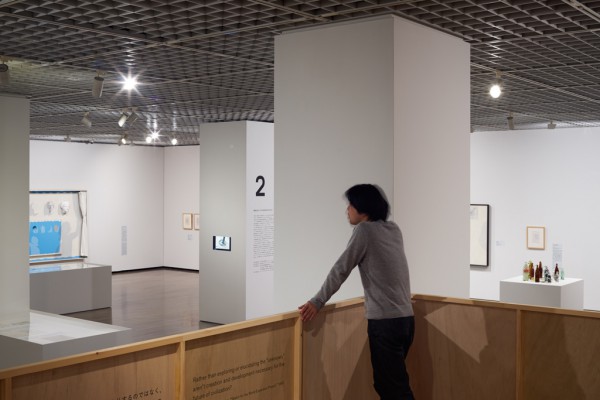主要用途: 展示会場構成
施工: 東京スタデオ
クレジット: 主催:東京国立近代美術館/グラフィック:菊地敦己/「影ラボ」の照明:遠藤照明
所在・会場: 東京国立近代美術館
延床面積: 1118m2
設計期間: 2014.02-2014.10
施工期間: 2014.11
会期: 2014.12.2-2015.3.1
写真: 阿野太一
ウェブサイト: http://www.momat.go.jp/Honkan/takamatsujiro/index.html
東京国立近代美術館で開催された高松次郎(1936-1998)の回顧展「高松次郎ミステリーズ」の会場構成。この展覧会では、3人のキュレーター(桝田倫広・蔵屋美香・保坂健二朗)がそれぞれ初期・中期・後期の3章を分担した。各章ごとにスタイルの異なる作品群を、関連性を追って丁寧に見せながらも、全体としてはひとつの大きな広場を散策するような、おおらかな展示空間が求められた。展覧会の導入部となる、「影ラボ」と名付けた細長い展示空間は、体験型のインスタレーションの場とした。異なる光源で影が二重に見えたり、回転する椅子の影が投影されたりと、4つのテーマで高松の中期の作品のポイントを体感的に知ることができる。影ラボを抜けるとメインとなる展示室にたどり着く。もともとこの展示室には、断面形状の異なる6本の柱が林立している。そこで、この6本の柱を、構造体としての存在を消しつつも、展示空間全体の風景を構成するヴォリュームとして扱えないかと考えた。近接する柱と同じ断面形状の疑似柱5本と展示什器を新たにつくり、既存柱の存在を紛らわせる計画とした。大小の白いヴォリュームが点在することで、次の展示エリアが見え隠れし、一体の展示空間の中に適度な分節を与えている。3章の最後には、展示室の中央にある大きなステージにたどり着く。1章のエリアから視界に入っていた中央の白いヴォリューム内部は、高松のアトリエを偲ばせる木質系の表情があらわになっている。中央のステージからはこれまで見てきた作品群を俯瞰することができ、腰壁に配された高松の言説とともに、これまでバラバラに見えていた作品間の関連性に気づかされる。ステージ上は休憩のためのスペースで、晩年のスケッチから再現した形のクッションに腰を下ろして図録を読むことができる。このステージの大きさは、ちょうど高松が制作活動を行っていたアトリエと同等の大きさで出来ており、高松の制作の空間を象徴的に重ね合わせている。約200点に及ぶ作品群を通じて高松の思考を追体験しながら、その背後にある関連性を読み解いていくようなミステリーを空間で演出したいと考えた。 All photos on this page are copyrighted material and all rights are reserved. ©The Estate of Jiro Takamatsu, Courtesy of Yumiko Chiba Associates
Principle use: EXHIBITION SITE
Production: TOKYO STUDIO
Credit: Organizer: The National Museum of Modern Art, Tokyo / Graphics: Atsuki Kikuchi / Lighting of “Shadow Lab”: ENDO Lighting
Building site: The National Museum of Modern Art, Tokyo
Total floor area: 1118m2
Design period: 2014.02-2014.10
Construction period: 2014.11
Duration: 2014.12.2-2015.3.1
Photo: Daici Ano
Website:http://www.momat.go.jp/Honkan/takamatsujiro/index.html
We designed the exhibition site for the Jiro Takamatsu (1936-1998) retrospective presented at the National Museum of Modern Art.The exhibition was curated by Tomohiro Masuda, Mika Kuraya and Kenjiro Hosaka who oversaw the early, middle and latter chapters of Takamatsu’s work respectively. We were tasked with providing a lofty exhibition space where visitors could wander through his legacy like a public square while bringing out the common thread of his stylistically heterogeneous body of work.The exhibition opens with the “shadow laboratory”, a long and narrow interactive installation where highlights from the middle period, such as overlapping shadows cast by different sources of light or the silhouette of a spinning chair, are presented in four themes.This area leads to the main exhibition space where can be found six columns of varying girth, which are volumes intended to give form to the scenery while downplaying their presence as structural elements. Moreover, our design calls for five pseudo-columns with the same girth in their vicinity to be used as furniture for the exhibition and further divert attention from the existing columns. Adequate separation within each section was achieved by populating the venue with these white volumes of various sizes to screen off adjacent areas.Finally, visitors reach the last section where a “stage” is hidden behind the central volume located at the center of the venue, and which is visible from the first area. This stage reveals wooden accents reminiscent of Takamatsu’s studio while offering a vantage point from which all the works seen hitherto can be taken in at a glance. Furthermore, quotes from the artist placed on the half-wall help bring into focus the recurring themes of his diverse works. The top of the stage is intended as a resting area where visitors can browse through illustrated books while sitting on cushions reproducing designs found in sketches from the latter part of his career. The size of the stage symbolically echoes Takamatsu’s sphere of creation since its dimensions match that of the studio where he worked during his active period.Through this exhibition made up of approximately 200 works of art, we sought to create a space where visitors could experience for themselves Takamatsu’s vast philosophical world as they solve the mysteries contained in his work. All photos on this page are copyrighted material and all rights are reserved. ©The Estate of Jiro Takamatsu, Courtesy of Yumiko Chiba Associates
